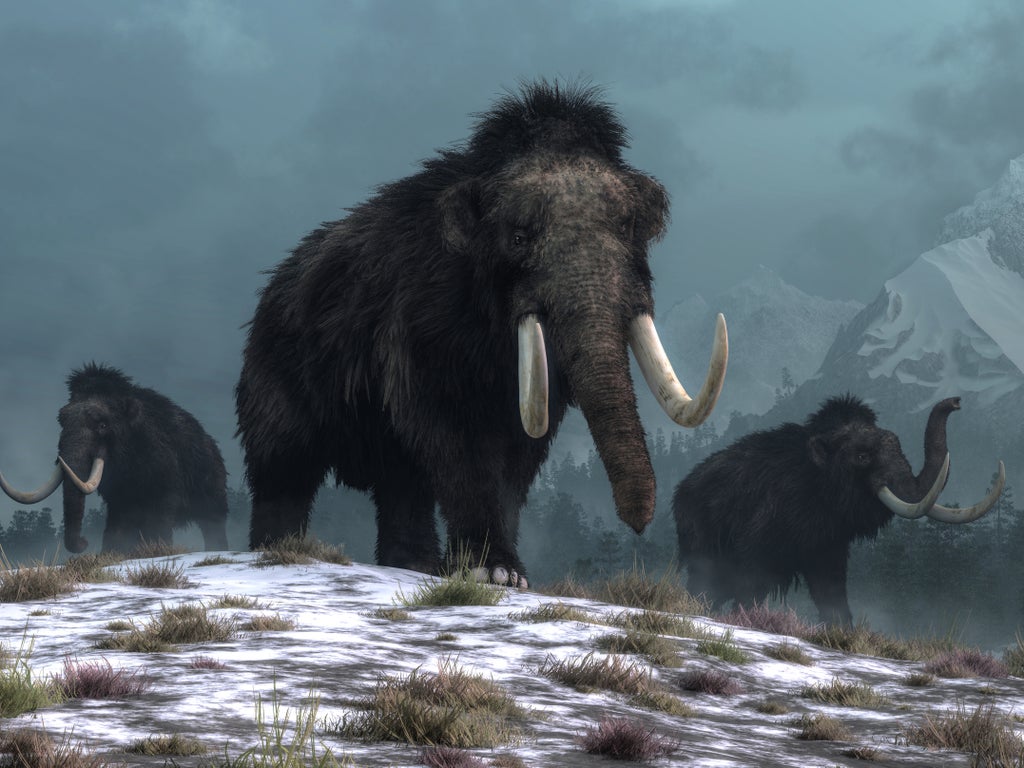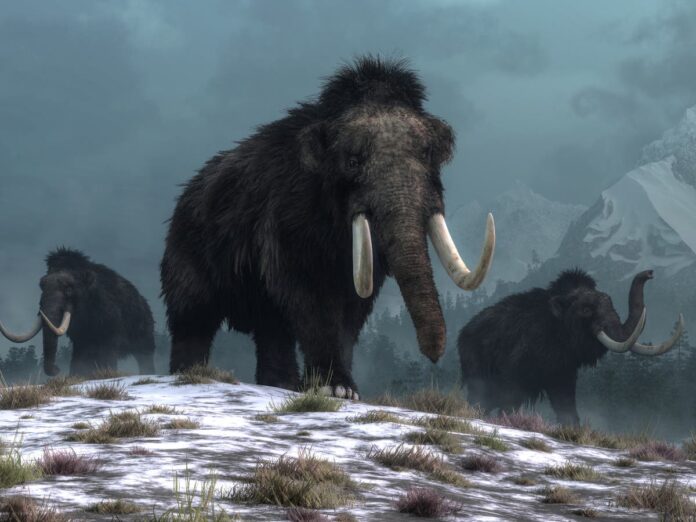[ad_1]

For around five million years, various species of mammoth walked the Earth, and lived across Africa, Asia, Europe, and the Americas.
The last species to emerge – the shaggy-coated woolly mammoth – evolved in East Asia around 600,000 years ago and survived until the last one died out on Russia’s Wrangel Island, in the Arctic Ocean until as recently as 4,000 years ago.
But was it humans that were responsible for their demise? Or was it something else?
It is known that for millennia, humans and mammoths coexisted: people drew pictures of mammoths on cave walls 30,000 years ago.
Humans also hunted mammoths, using their skeletons to build shelters, their tusks to carve harpoons; the world’s oldest-known musical instrument is a flute carved out of mammoth bone.
But now new research suggests that it wasn’t human pressures that ultimately drove mammoths to extinction, but instead ancient changes to the climate that made it too wet for them to survive.
In a groundbreaking 10-year-long research project, geneticists from the University of Cambridge and the University of Copenhagen analysed ancient environmental DNA and say they have proved mammoths were pushed to extinction because of a warming climate.
They say that when the ice receded following the last ice age, a rapid transformation of the climate made it too wet to sustain the level of vegetation the giant animals needed to survive.
The team used a technique called “DNA shotgun sequencing” to analyse environmental plant and animal remains – including urine, faeces and skin cells – taken from soil samples carefully collected over a period of 20 years from sites in the Arctic where mammoth remains were found.
This new technique – similar to the methods used during the Covid pandemic to test sewage to analyse the spread of the virus – means scientists no longer have to rely on DNA samples from bones or teeth and hope to gather enough genetic material to recreate a profile of ancient DNA.
Professor Eske Willerslev from St John’s College, Cambridge, said: “Scientists have argued for 100 years about why mammoths went extinct. Humans have been blamed because the animals had survived for millions of years without climate change killing them off before, but when they lived alongside humans they didn’t last long and we were accused of hunting them to death.
“We have finally been able to prove that it was not just the climate changing that was the problem, but the speed of it that was the final nail in the coffin – they were not able to adapt quickly enough when the landscape dramatically transformed and their food became scarce.”
He added: “As the climate warmed up, trees and wetland plants took over and replaced the mammoth’s grassland habitats. And we should remember that there were a lot of animals around that were easier to hunt than a giant woolly mammoth – they could grow to the height of a double-decker bus.”
Despite the harsh conditions in which they lived, the animals would have thrived. Alongside woolly mammoths, herds of reindeer and woolly rhinoceroses would also have lived, all sustained on the abundant vegetation which included grasses, flowers, plants, and small shrubs. These would all have been eaten by the vegetarian mammoths who probably used their tusks to shovel snow aside before uprooting tough grasses.
Dr Yucheng Wang, first author of the paper and a Research Associate at the Department of Zoology, University of Cambridge, said: “The most recent Ice Age – called the Pleistocene – ended 12,000 years ago when the glaciers began to melt and the roaming range of the herds of mammoths decreased.
“It was thought that mammoths began to go extinct then but we also found they actually survived beyond the Ice Age all in different regions of the Arctic and into the Holocene – the time that we are currently living in – far longer than scientists realised.
“We zoomed into the intricate detail of the environmental DNA and mapped out the population spread of these mammals and show how it becomes smaller and smaller and their genetic diversity gets smaller and smaller too, which made it even harder for them to survive.”
He added: “When the climate got wetter and the ice began to melt it led to the formation of lakes, rivers, and marshes. The ecosystem changed and the biomass of the vegetation reduced and would not have been able to sustain the herds of mammoths.
“We have shown that climate change, specifically precipitation, directly drives the change in the vegetation – humans had no impact on them at all based on our models.”
With the current climate crisis worsening due to anthropogenic emissions, while humans may not have been to blame in the past, we are already contributing to a major extinction event now.
Professor Willerslev said the speed of the changes which affected the mammoths was “a stark lesson from history and shows how unpredictable climate change is”.
“Once something is lost, there is no going back. Precipitation was the cause of the extinction of woolly mammoths through the changes to plants. The change happened so quickly that they could not adapt and evolve to survive,” he said.
“It shows nothing is guaranteed when it comes to the impact of dramatic changes in the weather. The early humans would have seen the world change beyond all recognition – that could easily happen again and we cannot take for granted that we will even be around to witness it. The only thing we can predict with any certainty is that the change will be massive.”
The research is published in the journal Nature.
[ad_2]
Source link













